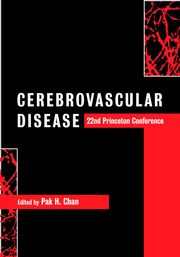Book contents
- Frontmatter
- Contents
- List of contributors
- Preface
- Acknowledgments
- Part I Special lectures
- Part II Oxidative stress
- Part III Apoptosis
- Part IV Hot topics
- Part V Hemorrhage, edema and secondary injury
- Part VI Inflammation
- 18 Inflammation and stroke: benefits or harm?
- 19 TNF-α and ceramide are involved in the mediation of neuronal tolerance to brain ischemia
- 20 Sites and mechanisms of IL-1 action in ischemic and excitotoxic brain damage
- 21 Protease generation, inflammation and cerebral microvascular activation
- Part VII Gene transfer and therapy
- Part VIII Neurogenesis and plasticity
- Part IX Magnetic resonance imaging in clinical stroke
- Part X Risk factors, clinical trials and new therapeutic horizons
- Index
- Plate section
21 - Protease generation, inflammation and cerebral microvascular activation
from Part VI - Inflammation
Published online by Cambridge University Press: 02 November 2009
- Frontmatter
- Contents
- List of contributors
- Preface
- Acknowledgments
- Part I Special lectures
- Part II Oxidative stress
- Part III Apoptosis
- Part IV Hot topics
- Part V Hemorrhage, edema and secondary injury
- Part VI Inflammation
- 18 Inflammation and stroke: benefits or harm?
- 19 TNF-α and ceramide are involved in the mediation of neuronal tolerance to brain ischemia
- 20 Sites and mechanisms of IL-1 action in ischemic and excitotoxic brain damage
- 21 Protease generation, inflammation and cerebral microvascular activation
- Part VII Gene transfer and therapy
- Part VIII Neurogenesis and plasticity
- Part IX Magnetic resonance imaging in clinical stroke
- Part X Risk factors, clinical trials and new therapeutic horizons
- Index
- Plate section
Summary
Introduction
Middle cerebral artery occlusion (MCAO) promotes occlusion of downstream microvessels, which leads to microvascular perfusion defects, and initiates cellular inflammation, which requires the sequential expression of leukocyte adhesion receptors on microvascular endothelial cells. Changes in microvascular integrity and permeability, loss of basal lamina integrity, simultaneous decreases in specific endothelial cell and astrocyte integrins and changes in astrocyte ultrastructure also occur during early ischemia. Endothelial cell leukocyte adhesion receptors respond to ischemia in a rapid and orderly way, to initiate the cellular inflammatory response. P-selectin appears on the endothelium by 2 hours of MCAO, followed by intercellular adhesion molecule-1 by 4 hours and E-selectin between 7 and 24 hours after MCAO (during reperfusion). Also, integrin αVβ3 is rapidly expressed by microvascular myointimal smooth muscle cells within 2 hours of MCAO. Those findings are consistent with the view that both microvascular and neuron injury may occur much more rapidly than the time frame for the appearance of cellular inflammatory cells in the primate basal ganglia.
Cerebral capillaries consist of endothelial cells, basal lamina (a portion of the extracellular matrix (ECM)) and astrocyte end-feet. Anatomical and functional relationships support their consideration as unique ternary complexes. In the adult brain, the ECM is found as the basal lamina in microvessels and within the meninges, in addition to other sites. In non-capillary microvessels, individual smooth muscle cells are encased in the ECM, which is continuous with the basal lamina.
- Type
- Chapter
- Information
- Cerebrovascular Disease22nd Princeton Conference, pp. 247 - 258Publisher: Cambridge University PressPrint publication year: 2002



